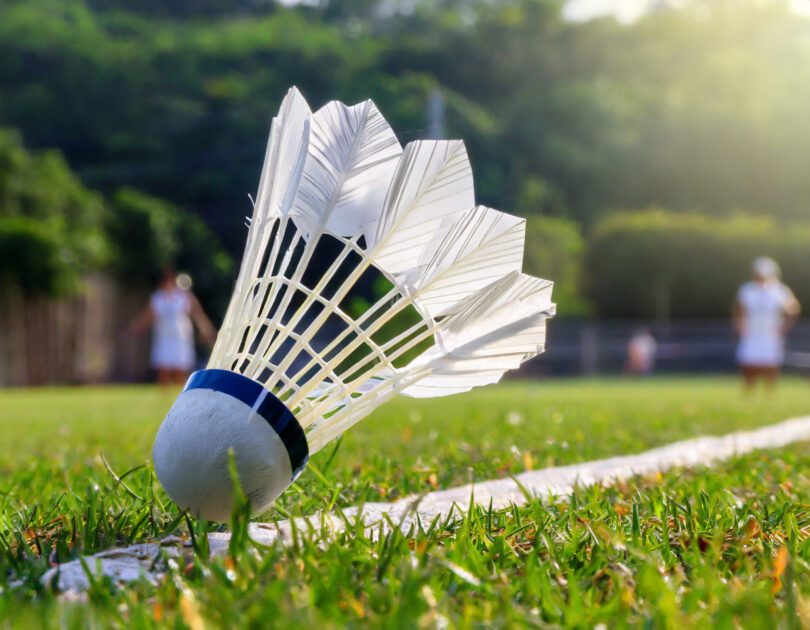Before we dive into the line calls debate, let’s get acquainted with the badminton court itself. Badminton courts come in two sizes: singles and doubles. The singles court is narrower than the doubles court, which means the boundaries play a crucial role in determining the outcome of the match.
The Net and Center Line
At the heart of the court lies the net, which is suspended over the center line. The net divides the court into two halves, and the center line marks the boundary between these halves. This line is critical for serving and determining fault.
The Sideline and Baseline
The sideline runs parallel to the net and marks the court’s lateral boundary, while the baseline stretches across the width of the court, marking its rear boundary. It’s important to note that the singles and doubles courts have different sideline dimensions, adding to the complexity of the game.
In or Out? The Rules and Challenges
The Basics of a Legal Shot :
In badminton, the objective is clear: to ensure the shuttlecock lands within the boundaries of the court. If the shuttlecock lands outside the court’s boundaries, it’s considered “out,” and the opposing player or team earns a point. But how do you determine if a shot is in or out?
Everyday Line Call Situations:
Determining whether a shot is in or out can be challenging, especially when the shuttlecock is flying at high speeds or hovering near the lines. There are several standard line call situations that players encounter during a match.
Fast Shots and Close Calls:
When a player delivers a lightning-fast smash or a drop shot that hugs the line, making a quick and accurate line call can be a daunting task. The margin for error is slim, and this is where the debate often heats up.
High Shots and Lobs:
High shots, like lobs, pose a different challenge. As the shuttlecock soars high above the court, players must keep a keen eye on its trajectory and ensure it lands within the boundaries.
Service Line Calls:
Service line calls are critical in badminton, as serving faults can lead to point losses. Both the server and the receiver need to watch for accurate service line calls.
Line Judges and Technology
The Role of Line Judges:
In professional badminton matches, line judges play a vital role in determining the legality of shots. They are responsible for making real-time line call judgments, which can be incredibly challenging, given the speed of the game.
The Use of Technology:
In recent years, technology has come to the aid of line judges and players alike. HawkEye and instant replay systems have been introduced to assist in making accurate line calls, reducing human error and controversies.
Strategies for Dealing with Line Calls
Accepting the Umpire’s Decision:
It’s essential to respect the umpire’s decision, even if you disagree with it. Arguing over line calls can disrupt the flow of the game and is generally discouraged.
Challenging Line Calls:
In some cases, players have the option to challenge line calls, especially in professional matches. However, it’s essential to understand when and how to challenge effectively.
When to Challenge:
Challenges should only be made when there is a genuine belief that the umpire’s call was incorrect. Understanding the rules governing challenges is crucial.
Consequences of Challenging:
Challenging a line call comes with consequences. Players must be aware of the possible outcomes and the impact it can have on the match.
Controversial Line Calls in Badminton History
Notable Line Call Controversies:
Over the years, badminton has seen its fair share of line-call controversies, even in high-profile events like the Olympic Games.
Olympic Games Incidents:
The Olympic Games have witnessed several unforgettable line call controversies that have left spectators and players stunned.
High-Profile Matches:
Even in nonOlympic events, high-profile matches have had their moments of line-call drama. These incidents have added to the sport’s intrigue.
How to Improve Your Line Calling
Practicing Line Judgment:
Improving your line-calling skills requires practice and experience. Regularly participating in matches and honing your judgment can make a significant difference.
Understanding Angles and Perspectives:
Recognizing how angles and perspectives affect line calls is crucial, especially in doubles matches where multiple lines need to be monitored.
Singles vs Doubles Challenges:
Singles and doubles have their unique line-call challenges. Understanding these distinctions can help you make more accurate judgments.
The Importance of Sportsmanship
Respecting Your Opponent:
Regardless of the outcome of a line call, it’s essential to maintain sportsmanship and respect for your opponent. Good sportsmanship is at the core of any sport.
Dealing with Disagreements:
Disagreements over line calls are bound to happen, but how you handle them speaks volumes about your character as a player. Finding amicable solutions is key.
Conclusion
Mastering the art of line calls in badminton is no easy task. It requires skill, practice, and understanding of the rules. While controversies may arise, it’s essential to remember that the thrill of badminton’s boundary battle makes the sport so exciting. So, the next time you step onto the court, keep a sharp eye on those lines, and let the game begin!


9 thoughts on “Inside or Outside? 10 Guides For Badminton’s Court line Calls”